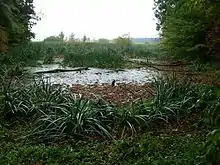淤泥
淤泥(),又稱沉泥或粉土,是泥土的基本組成成份之一。地質學中,淤泥是介於沙土及黏土之間,長約2到62微米、直徑4到9微米的一種顆粒狀物料,主要由石英及长石這兩種礦物組成[1]。淤泥可能以土壤的成份或悬浊水體內的沉積物兩種形式出現。當河道泛濫,又或被山崩時的泥石流帶動,淤泥會在流動時隨同水體在沿途沉積成為土壤。由於淤泥的比表面积屬中度,非黏粘,有好像塑膠那樣帶彈性。當完全乾燥時,淤泥會變回粉塵般的幼細,但潮濕後立即又變回黏滑。在手持的放大鏡下,淤泥清晰可見,往往帶有尖銳的外表。當以牙齒咬或以舌頭觸摸時,這種棱角亦能感覺到,而這亦是分辨水中的淤泥或黏土的一種方法。
來源
淤泥是通過對其原石施以各種物理過程而產生。這些物理過程能夠通過利用原石內沙粒大小的石英晶体中的缺陷,將這些石英沙粒再細分[2]。這些物理過程包括有:岩石表岩屑的風化作用[3]、霜凍作用[4]和鹵蟲成形術[5]。當中主要的過程是岩石在被水體運輸時造成的磨損作用,例如:河流粉碎、風成磨損和冰川研磨[6]。在半乾旱環境[7]中,產生了大量的淤泥。乾燥後的淤泥又名粉砂,特別是由冰川作用形成的淤泥。礦物學上,淤泥的主要成份是石英和长石。主要由淤泥組成的沉积岩被稱為粉砂岩。強烈地震造成的液化是懸浮在水中的淤泥,水流動力從地下開始向上推。
粒徑大小的條件
按巫登–溫特瓦分級(Udden–Wentworth scale),淤泥的粒徑屬於粉砂級的3.9至62.5 µm之間,比黏土大,但比沙粒小。國際標準化組織的ISO 14688將淤泥的粒徑定為2 µm-6 µm 到 20 µm-63 µm,然後再分為幼粒、中等和粗粒三等。實際上,淤泥在化學上的成份與黏土完全不同;此外淤泥的粒徑在各個方向都大致相同,這一點亦是與黏土不同。再者,淤泥的尺寸往往重疊,即有多種不同粒徑的粉砂混合在一起。反而黏土由通過靜電力保持在一起的薄板狀顆粒形成,因此具有內聚力;相反淤泥並沒有這種內聚力。根據美国农业部(USDA)的土壤質地分類系統()沙土和淤泥以0.05 mm的顆粒為分野[8]。這套由美国农业部開發的系統後來亦為联合国粮食及农业组织(FAO)所採納。
環境影響
Silt is easily transported in 水 or other liquid and is fine enough to be carried long distances by air in the form of 灰塵. Thick deposits of silty material resulting from deposition by 風蝕 are often called 黃土. Silt and clay contribute to 濁度 in water. Silt is transported by 溪s or by water currents in the 洋. When silt appears as a pollutant in water the phenomenon is known as siltation.
Silt, deposited by annual floods along the 尼罗河, created the rich, fertile soil that sustained the 古埃及ian civilization. Silt deposited by the 密西西比河 throughout the 20th century has decreased due to a system of 堤, contributing to the disappearance of protective 湿地 and 離岸沙洲 in the 密西西比河三角洲 region surrounding 新奥尔良.[9]
In southeast Bangladesh, in the 諾阿卡利縣, cross dams were built in the 1960s whereby silt gradually started forming new land called "chars". The district of Noakhali has gained more than 73平方(28平方英里) of land in the past 50 years.
With Dutch funding, the Bangladeshi government began to help develop older chars in the late 1970s, and the effort has since become a multi-agency operation building roads, 涵洞s, embankments, cyclone shelters, toilets and ponds, as well as distributing land to settlers. By fall 2010, the program will have allotted some 100平方(20,000英畝) to 21,000 families.[10]
A main source of silt in urban rivers is disturbance of soil by 建筑施工 activity.[11] A main source in rural rivers is 侵蚀作用 from plowing of farm fields, 皆伐 or 刀耕火耨 treatment of 森林s.
參考文獻
- Assallay, A.M.; Rogers, C.D.F.; Smalley, I.J.; Jefferson, I. . Earth-Science Reviews. 1998, 45: 61–88.
- Moss, A J; Green, P. . Australian Journal of Earth Sciences. 1975, 22 (4): 485–495. Bibcode:1975AuJES..22..485M. doi:10.1080/00167617508728913.
- Nahon, D; Trompette, R. . Sedimentology. 1982, 29: 25–35. Bibcode:1982Sedim..29...25N. doi:10.1111/j.1365-3091.1982.tb01706.x.
- Lautridou, J P; Ozouf, J C. . Progress in Physical Geography. 1982, 6 (2): 215–232. doi:10.1177/030913338200600202.
- Goudie, A S; Viles, H A. . Earth Surface Processes and Landforms. 1995, 9: 95–98. Bibcode:1984ESPL....9...95G. doi:10.1002/esp.3290090112.
- Wright, J S; Smith, B J; Whalley W B. . Geomorphology. 1998, 45: 15–34. Bibcode:1998Geomo..23...15W. doi:10.1016/S0169-555X(97)00084-6.
- Haberlah, D. . AREA. 2007, 39 (2): 224–229. doi:10.1111/j.1475-4762.2007.00730.x.
- . National Soil Survey Handbook Part 618 (42-55) Soil Properties and Qualities. United States Department of Agriculture - Natural Resource Conservation Service. [2006-05-31]. (原始内容存档于2006-05-27).
- . USGS Biological Resources. [2006-03-08]. (原始内容存档于2005-10-28).
- . [October 22, 2009]. (原始内容存档于February 12, 2010).
- Leedy, Daniel L.; Franklin, Thomas M.; Maestro, Robert M. . U.S. Department of the Interior, Fish and Wildlife Service, Eastern Energy and Land Use Team. 1981. (原始内容存档于2017-12-24) (英语).
- Hart 1986,第22頁;Freeman 1997,第91頁.
參看
- 侵蝕控制
- Nonpoint source pollution
- Sediment control
- Silt fence
- Siltation

